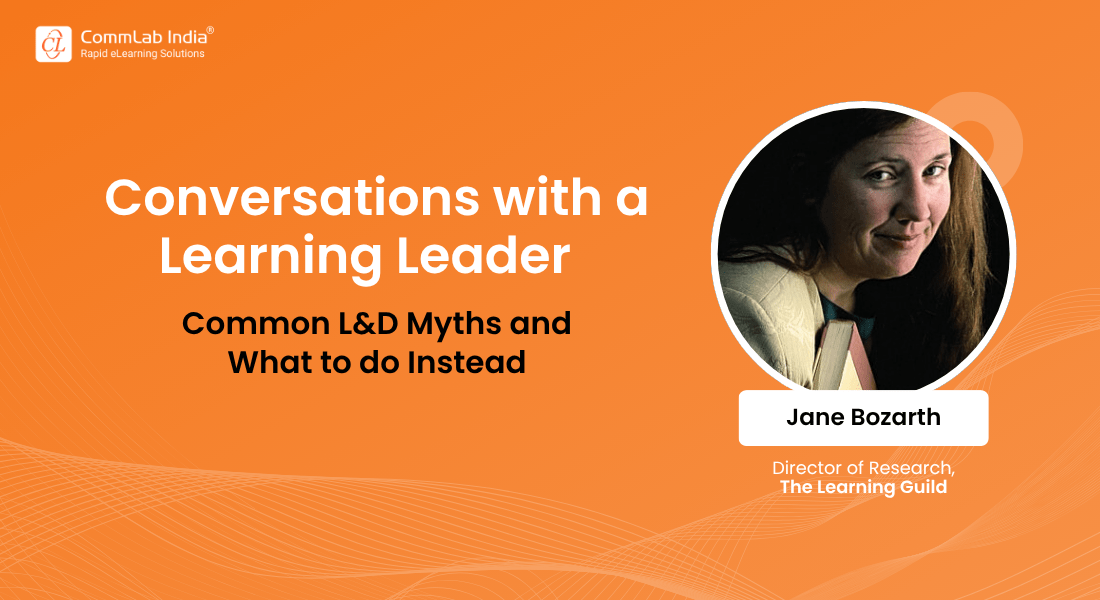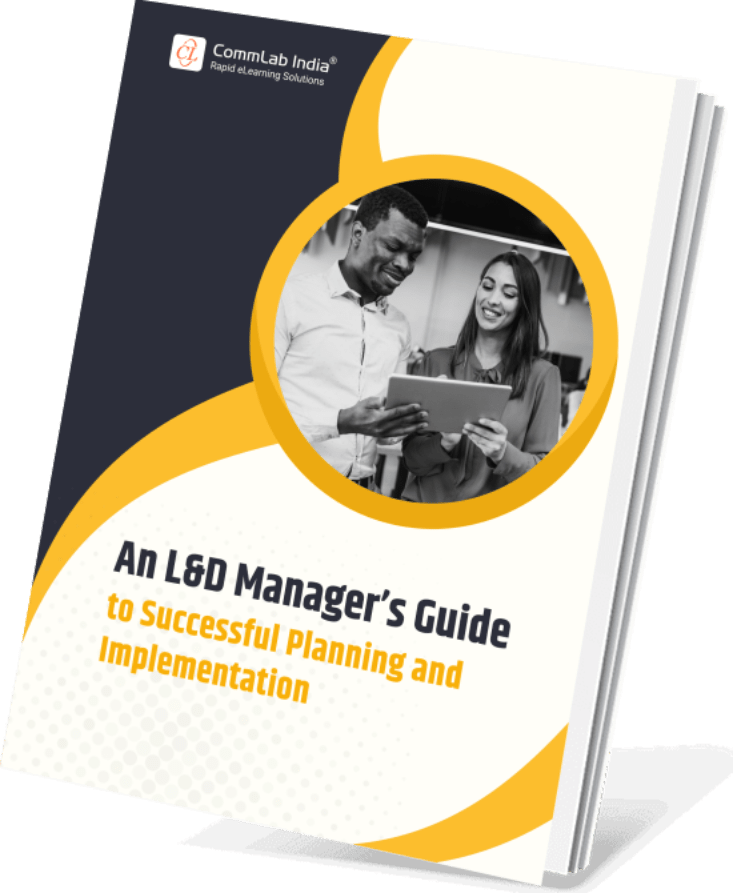L&D Myths vs. Reality — Podcast Excerpt

Ever hear something about Learning and Development (L&D) that just sounded... off? Like when someone says, “All employees learn the same way,” or “The more content, the better the training.” These are the kinds of "truths" that get repeated so often they start to feel like solid advice, even when they fall flat in practice.
The problem? Clinging to these myths can lead to wasted time, missed opportunities, and drained L&D budgets. Worse, they can leave employees feeling uninspired or overwhelmed, which is the opposite of what great training should do.
So, let’s hit pause, clear the air, and focus on what really drives results when designing employee training and development programs. From tailoring learning experiences to embracing new technologies, there are strategies that actually work, and we’re here to unpack them. Let’s jump in and set the record straight!
In this excerpt from CommLab India’s eLearning Champion podcast, we delve into common L&D myths and what to do instead, from valuable tips to inspiration. We’re joined by Jane Bozarth, Director of Research for the Learning Guild, who brings a wealth of experience as a classroom trainer, eLearning instructional designer, facilitator, and learning program manager.
Tune into the podcast for interesting and actionable insights!
Table Of Content
- Common Myths in Learning and Development
- Emerging Technologies in Learning and Development
- Bringing It All Together
Common Myths in Learning and Development
Jane identifies three major myths that are rampantin the L&D field. She emphasizes the need to move away from intuitive but unsupported beliefs and instead focus on evidence-based practices that truly enhance learning outcomes.
Are These L&D Myths Holding You Back?
Discover the truth behind common myths in learning and development, including misconceptions about:
Myth 1: People Learn Better When Teaching Matches Their Learning Style
Myth 2: Personality Types Drive Behavior and Teamwork
Myth 3: Generational Labels Shape Learning and Workplace Preferences
Myth 1: People Learn Best When Teaching Matches Their Learning Styles
The idea of learning styles suggests that people learn best when instruction matches their preferred style, such as visual, auditory, or kinesthetic. While appealing, this concept lacks scientific evidence. Studies consistently show that tailoring teaching to learning styles does not improve outcomes. Instead, effective instruction should focus on the content being taught. For example, visual aids work better for spatial or graphical concepts, while hands-on activities are ideal for skill-based learning.
Imagine you’re given two days of professional development a year, and the sessions offered are “learning styles” one day and “how to do PowerPoint” the next. It’s not just frustrating, it’s ineffective. Rather than focusing on outdated myths or generic tools, meaningful professional development would prioritize teaching strategies aligned with the material, ensuring more impactful learning experiences. Prioritizing the nature of the content over personal preferences leads to better outcomes for everyone.
Myth 2: Personality Types Accurately Predict Behavior and Teamwork
Personality type assessments are often used in workplaces to predict behavior, guide teamwork, or teach communication strategies. However, these tools often lack scientific validity and tend to oversimplify the intricate nature of human behavior. They have poor predictive accuracy and can lead to inaccurate generalizations by categorizing individuals into predefined "types."
Let’s clear something up: People absolutely have preferences. But preference doesn’t equal performance. It’s better to use evidence-based frameworks that acknowledge the nuances of behavior and interpersonal dynamics, focusing on learning strategies rather than oversimplified personality typing.
Myth 3: Generational Labels Define Learning and Workplace Preferences
The belief that different generations—like Baby Boomers, Millennials, or Gen Z—have fundamentally different learning needs or workplace preferences is a common misconception. These labels often lead to stereotypes and reinforce biases.
Forbes reports that job hopping has become the "new normal" for younger generations. While the average worker stays at a job for 4.4 years, Millennials and Gen Z workers tend to switch jobs more frequently, often every 2–3 years. However, evidence supporting generational differences in learning or behavior remains weak. Instead, it's more effective to consider factors such as life circumstances, individual experiences, and cultural context. Focusing on these deeper influences helps organizations create inclusive, effective learning environments that meet genuine needs rather than perpetuating stereotypes.

An L&D Manager's Guide to Successful Planning & Implementation.
Learn:
- What Challenges do L&D Managers Face?
- How to Align Business and Project?
- How to be a Learning Consultancy?
- DOWNLOAD NOW!
Emerging Technologies in Learning and Development
The future of L&D is full of opportunities to create more inclusive and accessible learning experiences. While tools like screen readers have been vital, emerging technologies in L&D are taking accessibility to the next level.
Here are some emerging technologies driving this transformation:
1. AI-generated video
AI-generated video is transforming workplace learning by delivering personalized and adaptive learning content designed to meet the diverse needs of employees. Whether it’s onboarding new hires, ongoing training, or advanced skill development, AI tools like Synthesia, Colossyan, Vyond and others make it easy to create engaging video content quickly. These platforms enable organizations to produce custom training materials in minutes, complete with multilingual voiceovers, realistic avatars, and dynamic visuals.

By analyzing employee performance and learning preferences, AI-powered video development ensures training videos are relevant, efficient, and impactful. This technology is redefining employee training and development, driving growth and productivity.
2. 3D Printing
Revolutionizing workplace training, 3D printing creates tactile, hands-on resources such as models for product training, technical processes, or simulations. This technology is especially beneficial for making training more inclusive, providing accessible learning tools tailored for employees with disabilities or different learning styles. By offering a more immersive and customizable experience, 3D printing helps bridge gaps in traditional training methods.

3. Blockchain Credentialing
Transforming how skills and certifications are validated, blockchain-based credentialing ensures secure, tamper-proof records of employee qualifications. This technology allows employees to easily showcase their skills to prospective employers or within their current organization, fostering transparency and trust in career progression. It also simplifies cross-border recognition of credentials, promoting professional mobility and empowering workers to advance their careers with confidence in a digital-first world.
These innovations are more than just tools—they’re keys to building an equitable corporate training environment. By embracing these technologies, companies can ensure every employee, regardless of ability, has the opportunity to succeed and contribute. The future of corporate training has never been more promising.
Bringing It All Together
L&D is pivotal for driving business growth, but navigating its challenges requires a deeper understanding of what works and what doesn’t. Addressing misconceptions and aligning training strategies with business goals is no small feat. As an L&D manager, you’re tasked with balancing employee growth, organizational objectives, and measurable outcomes—all while overcoming roadblocks like limited budgets, buy-in from leadership, and evolving workforce needs.
Ready to take your L&D strategy to the next level? Dive into our eBook, where we explore key challenges for L&D managers, how to align training needs with business goals, and actionable strategies for designing impactful learning journeys. Discover how to create tailored roadmaps, implement effective solutions, and measure the real-world impact of your corporate training programs. Download the eBook today and start transforming your approach to L&D!





![4 Ways to Facilitate Informal Learning at the Workplace [Infographic]](https://blog.commlabindia.com/hubfs/Imported_Blog_Media/informal-learning-workplace.jpg)
